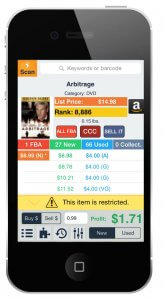
Editor’s Note: Originally published on May 28, 2019. Last updated on Dec. 7, 2022.
Thinking about retail arbitrage It’s the practice of buying pro… More? So are we. Find out what challenges you may face trying to resell on Amazon, and learn about how Profit Bandit can help.
Table of Contents
Amazon is changing so fast that it’s hard for sellers to keep up with it. A case in point is retail arbitrage It’s the practice of buying pro… More. Although it’s a topic that doesn’t come up in seller circles anymore, this business model fascinates people to this day, especially since there are so many books on the topic.
Sellers sign up to the Pro merchant service on Amazon all the time, but some do it specifically because they’ve read about retail arbitrage. They might even sign up to Profit Bandit. But when the time comes for them to list items, they realize they have some unanswered questions.
Why Do I Need to “Request Approval”?
There are some things you can never sell on Amazon, such as tobacco and lasers. These are called restricted products. But more and more products have extra selling restrictions. Sellers tend to call these product categories, types, and brands “gated Selling certain products and bran… More”.
You can tell an item is “gated” as soon as you try to list it on Amazon. First you see a “Listing limitations apply” warning. Next, you’re prompted to “Request Approval”. Then they ask for invoices and letters from the manufacturer/wholesaler that prove you’re allowed to resell on Amazon.
For more on this, please read this Help page. You can also find information about it on our blog. We recommend that you read our articles on gated brands and gated product categories before going forward with buying an item that’s meant to be listed on Amazon.
Can Profit Bandit Help?
Profit Bandit comes with a clever feature called Restricted items alert. As pictured below, it gives you a sneak peek at the item’s listing restrictions. Simply scan a product’s barcode or enter it manually to see if you’re free to sell it on Amazon.

Note that you must first log into your Amazon account to see the listing restriction alerts in Profit Bandit. That’s because some restrictions may only apply to particular venues, regions, sellers, or types of selling accounts (e.g., items only sellable on the B2B platform).
As a scouting app, Profit Bandit is best used to help you decide what to buy for resale. It shows you competition, sales ranks, lowest price Simply the lowest price an Amazon… More, and estimated profit for items that are already listed. So, it gives you everything you need to know before you buy.
Unfortunately, Profit Bandit can’t help you list new items. And it certainly won’t help you lift any restrictions. However, it can be used to check a listing for a product identical or similar to yours, to see if the brand or category is gated Selling certain products and bran… More.
How Did People Get Rich with Retail Arbitrage?
In its day, retail arbitrage was very profitable, as was the “buy low, sell high” strategy. Sellers bought stock by the pallet at auctions and clearances. Some only traded online, and many drop-shipped.
But buying in bulk meant they couldn’t check if the products were authentic. So, with bulk-buys came counterfeits. Then Amazon started to ask for itemized invoices. Soon after, sellers were stuck with duds because bulk items didn’t comply with requirements.
As wholesalers found other ways to dispose of overstock, retail arbitrage It’s the practice of buying pro… More fizzled out. But online arbitrage The practice of buying products f… More survived, and sellers found ways to order fewer units online, streamline their inventory, and lower their risk, without jeopardizing their business growth.
The Future of Retail Arbitrage
In April 2016, we predicted that three factors would affect the future of retail arbitrage. Below we mention these predictions and how they came true:
1. Itemized invoices are the norm.
This now applies to everyone who sells on Amazon, including private labelThis is what you call products manufactu… More sellers. Invoices are checked by the Seller PerformanceA measure of how well Amazon sellers are… More team. Contact information is verified. The supplier must be reachable and they must back you up. To comply with the rules, your invoice should:
- Be typed and dated within the past 365 days (fmly. 180 days).
- Feature the supplier’s logo and match their color scheme.
- State the supplier’s name, address, and contact details.
- Provide the official URL to the supplier’s professional-looking website.
- Include your address, which must match your seller address on record.
- Match the item’s Amazon title as closely as possible.
- Feature quantities consistent with your Amazon sales (at least 90 days’ worth of sales).
2. Listing guidelines are tougher.
Current condition guidelines are strict. One says an item is only new if the packaging is ‘intact’. But you can’t resell things on Amazon without checking that they’re genuine and complete. Unfortunately, if you open them, you may downgrade them. If so, you may need to consider using a different conditionProducts can only be listed on Amazon if… More category, such as Open Box, Renewed, or Collectible- Like New.
3. Brand owners are pushing out resellers.
Big brands are cracking down on resale. Thanks to Brand Registry, manufacturers and authorized sellers can remove and report resellers on a whim. Filing an appeal is time-consuming and unlikely to bring long-term security.
Should I Try Retail Arbitrage?
Back in 2017, we wrote a piece on the future of selling on Amazon. Our forecast was that more resellers would be forced to close up shop. Since then, we’ve seen a massive shift away from retail arbitrage It’s the practice of buying pro… More and onto private labelThis is what you call products manufactu… More.
But this doesn’t mean you shouldn’t give it a go. Start with whatever’s just lying around on your bookshelf and then move on to retailers’ online clearance pages. As long as you sell 40 items a month, the Pro account pays for itself. Just remember to tick all these boxes:
- join arbitrage groups on social media platforms;
- keep up with the latest news on seller forums and Amazon-themed blogs;
- swap ideas with other resellers at trade shows, summits, workshops, and webinars;
- use a reliable scouting app like Profit Bandit;
- look up costs with the FBA Revenue calculator;
- compare fulfillment channels.
Retail arbitrage is just one of the many ways people resell on Amazon today. Most third-party sellers carry a mix of inventory types from suppliers spread across the globe. If you’d like to know more about retail arbitrage, please don’t hesitate to get in touch via email or comments below. And don’t forget to subscribe to our blog for news, guest posts, and insider tips.

Melanie takes an active interest in all things Amazon. She keeps an eye on the latest developments and keeps Amazon sellers up to speed.






One Response
Hello and hope you are well. I’m a 72 year old trucker that’s looking at retiring and was looking at maybe trying retail arbitrage to help fill the money gap, but after reading several articles, it seems to me amazon just keeps adding fees and retrictions , to where I don’t know if it would be worth it or not, what do you think?